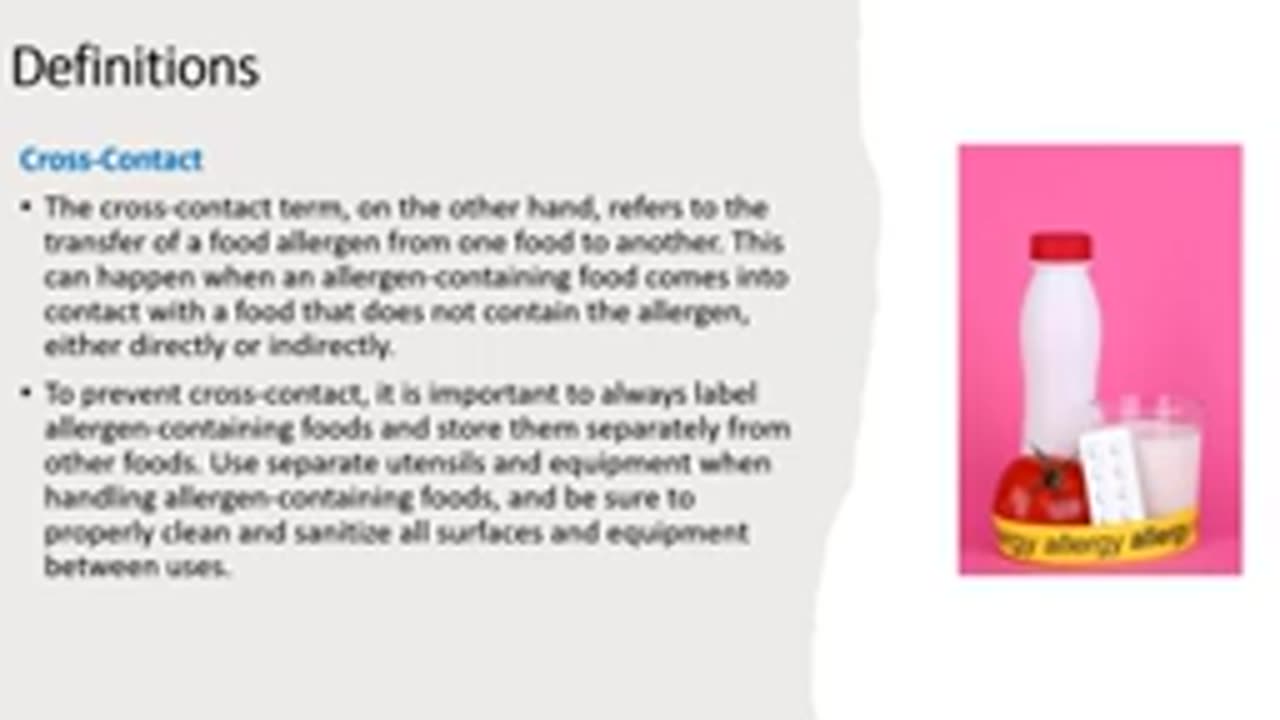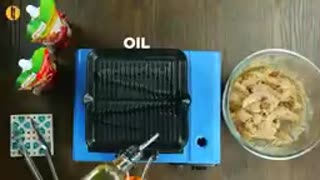Premium Only Content

Cross Contact vs Cross Contamination │ Food Safety
### **Cross Contact vs. Cross Contamination in Food Safety**
In the context of food safety, **cross contact** and **cross contamination** are related but distinct terms, and both pose risks to public health, especially for individuals with food allergies or compromised immune systems. Here’s how they differ:
---
### **1. Cross Contact**
**Definition:**
Cross contact occurs when allergens or substances from one food are transferred to another food, typically through shared utensils, equipment, or surfaces. This is a concern mainly for people with food allergies because even trace amounts of an allergen can trigger severe reactions.
**Key Points:**
- Cross contact refers specifically to allergens or food ingredients mixing unintentionally.
- It can occur even if the food items are not physically touching but come into contact via shared equipment or hands.
- For example, using the same knife to cut a peanut butter sandwich and a non-allergic sandwich could result in cross contact, potentially exposing someone with a peanut allergy to trace amounts of peanuts.
**Examples of Cross Contact:**
- Using the same fryer for both gluten-free and gluten-containing foods, which can transfer gluten.
- Preparing allergen-free food on the same cutting board as food containing allergens without proper cleaning.
- Using the same spoon to stir soup containing dairy and a dairy-free soup.
**Preventing Cross Contact:**
- Use dedicated equipment and utensils for allergen-free foods.
- Implement proper cleaning and sanitizing procedures.
- Clearly label foods to ensure consumers are aware of potential allergens.
- Separate preparation areas for foods with allergens and allergen-free foods.
---
### **2. Cross Contamination**
**Definition:**
Cross contamination occurs when harmful bacteria, viruses, or pathogens from one food or surface are transferred to another food. This typically happens through improper handling, storage, or preparation, and is a major concern for foodborne illnesses.
**Key Points:**
- Cross contamination is related to the transfer of **pathogens**, not just allergens.
- It can happen through direct contact or via indirect means such as contaminated equipment, utensils, or surfaces.
- It is particularly important to prevent cross contamination in raw foods like meat, poultry, and seafood, which may carry harmful microorganisms like Salmonella, E. coli, or Listeria.
**Examples of Cross Contamination:**
- Cutting raw chicken on a cutting board and then using the same board to cut vegetables without cleaning it.
- Storing raw meat on a top shelf in the refrigerator and having its juices drip onto ready-to-eat foods.
- Using a cloth towel that has touched raw meat to wipe down countertops or dishes.
**Preventing Cross Contamination:**
- Separate raw and cooked foods to avoid direct contact.
- Store raw foods (especially meats) at the bottom of the refrigerator to prevent juices from dripping onto other foods.
- Clean and sanitize all utensils, cutting boards, and surfaces between uses.
- Use color-coded cutting boards to differentiate between raw meat and ready-to-eat foods.
- Regularly wash hands and wear gloves when handling food, especially raw items.
---
### **Summary of Differences:**
| Aspect | **Cross Contact** | **Cross Contamination** |
|---------------------|-----------------------------------------------------|-----------------------------------------------------|
| **Definition** | Transfer of allergens between foods or surfaces. | Transfer of pathogens (bacteria, viruses) between foods. |
| **Focus** | Allergens, such as peanuts, dairy, or gluten. | Pathogens like Salmonella, E. coli, or Listeria. |
| **Primary Concern** | Food allergies and sensitivities. | Foodborne illness and safety. |
| **Cause** | Shared equipment, utensils, or surfaces. | Improper handling, storage, or preparation. |
| **Examples** | Peanut butter residue on a knife contaminating a non-peanut sandwich. | Raw chicken juice dripping onto vegetables. |
| **Prevention** | Separate utensils, clean surfaces, label allergens. | Separate raw and cooked foods, sanitize equipment. |
---
### **Why the Distinction Matters**
- **Cross contact** is a concern for **allergen management**. For example, those with food allergies could experience severe reactions if allergens are inadvertently transferred to their food.
- **Cross contamination** is a concern for **food safety and hygiene**. Pathogens from raw food can lead to foodborne illnesses if transferred to ready-to-eat food, often through improper handling or cleaning.
Both require vigilance in food handling, proper training for food handlers, and the implementation of food safety protocols to ensure the safety of consumers, whether they are avoiding allergens or harmful pathogens.
-
 1:35
1:35
HSESafetyInformation
7 months agoMutton Chops two ways- baked & grilled Recipe by Food Fusion (Eid Recipe)
68 -
 LIVE
LIVE
BigTallRedneck
3 hours agoPGA 2K25 - REDNECK'S WAY OR THE HIGHWAY
62 watching -
 LIVE
LIVE
megimu32
2 hours agoON THE SUBJECT: MTV | From 24/7 Music to… Silence?
76 watching -
 LIVE
LIVE
Reolock
4 hours agoWoW Classic Hardcore | More Ultra? Maybe Mage?
32 watching -
 1:02:05
1:02:05
BonginoReport
5 hours agoMusic Stars Go Viral For Anti-ICE Rants - Nightly Scroll w/ Hayley Caronia (Ep.157)
57.9K38 -
 LIVE
LIVE
Amish Zaku
4 hours agoBaldur's Gate 3 - Four Player Co-op Act 3
18 watching -
 LIVE
LIVE
Barry Cunningham
3 hours agoKINDA BREAKING NEWS! JOHN BOLTON HAS BEEN INDICTED! WHO'S NEXT!
4,908 watching -
 LIVE
LIVE
a12cat34dog
2 hours agoTRIPPIN' INTO THE UNKNOWN :: The Evil Within 2 :: SPOOKTOBER CONTINUES {18+}
132 watching -
 LIVE
LIVE
OhHiMark1776
5 hours ago🟠 10-16-25 ||||| Act 3 Continue ||||| Baldur's Gate 3 (2023)
79 watching -
 5:28:43
5:28:43
The Rabble Wrangler
20 hours agoBattlefield 6 with The Best in the West
10.3K1